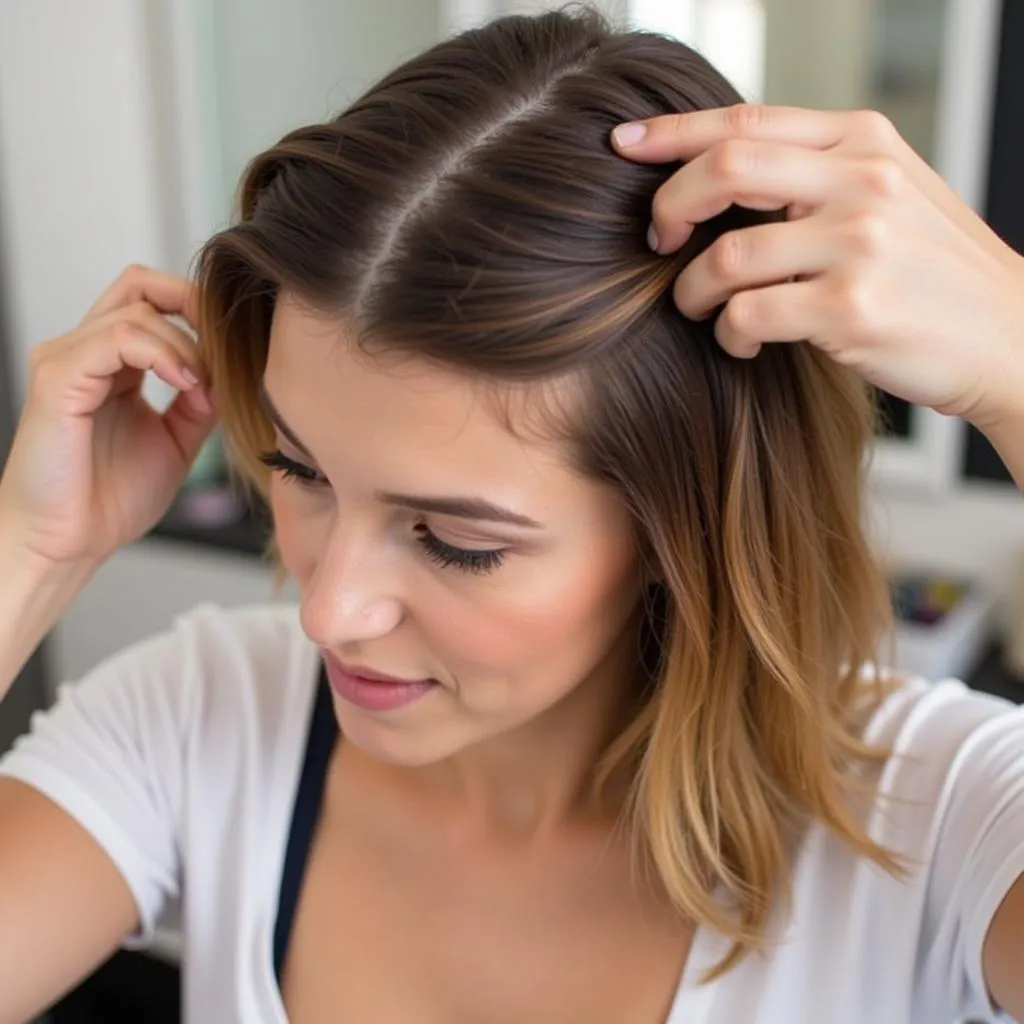Coloring your hair at home can be a great way to save money and achieve a fresh look. However, one common issue many people face is the dreaded “hot roots” phenomenon. This happens when the hair dye develops faster at the roots, resulting in a noticeably brighter or darker band of color compared to the rest of your hair.
But fear not, achieving even and natural-looking hair color is achievable with the right techniques. This article will explore the causes of hot roots and provide a comprehensive guide on how to avoid them, ensuring your at-home coloring experience yields stunning, salon-worthy results.
Understanding the Culprits Behind Hot Roots
Before we dive into the solutions, let’s shed light on the main culprits contributing to hot roots:
- Heat from the scalp: Your scalp naturally radiates heat, which accelerates the dye development process. This is why the roots, being closest to the heat source, tend to process faster.
- Dye application technique: Applying an excessive amount of dye to the roots, especially at the beginning, can overload the hair shaft with color, leading to uneven development.
- Hair porosity: Porous hair readily absorbs moisture, including hair dye. If your roots are more porous than the rest of your hair (often due to damage or previous chemical treatments), they’ll absorb more color, resulting in a darker or brighter appearance.
- Using the wrong developer: Using a developer with a higher volume than necessary can speed up the lightening process, making hot roots more prominent, particularly on virgin hair.
How to Prevent Hot Roots: Tried and True Techniques
Now that you understand the reasons behind hot roots, let’s explore proven strategies to avoid them during your next coloring session:
1. Start with Room-Temperature Hair
Before you even think about reaching for the dye, ensure your hair is completely dry and at room temperature. Freshly washed or damp hair can dilute the dye, while hot hair from styling tools can accelerate the development process, increasing the risk of hot roots.
2. Section Your Hair Like a Pro
Proper sectioning is key to achieving even color distribution. Divide your hair into four equal sections using clips – two at the front and two at the back. This systematic approach ensures that you apply dye to manageable sections, preventing any area from being oversaturated.
3. Begin Dye Application Away from the Roots
Instead of starting at the roots, begin applying the color about an inch away from your scalp. This allows the rest of your hair to process for a while before the heat from your scalp affects the roots.
 Applying hair dye section by section
Applying hair dye section by section
4. Tackle the Roots Last
Once you’ve applied dye to the mid-lengths and ends of your hair, let it process for about two-thirds of the recommended development time. Then, apply the remaining dye to your roots, ensuring even coverage.
5. Monitor the Development Process Closely
Keep a close eye on your hair as the dye develops. Since everyone’s hair reacts differently, you might need to adjust the processing time slightly. If you notice the roots developing faster than the rest of your hair, rinse them off earlier than the recommended time.
6. Choose the Right Developer for Your Hair Type
If you’re using a permanent hair color that requires a developer, opt for a lower volume, especially if you have virgin hair or are going for a subtle change. A lower volume developer will process more slowly and gently, minimizing the risk of hot roots.
Addressing Existing Hot Roots: Corrective Measures
If you’ve already fallen victim to hot roots, don’t panic. There are ways to correct the issue and achieve a more balanced color:
1. Tone Down With a Demi-Permanent Color
Demi-permanent color can help neutralize unwanted brassiness or darkness in the roots. Choose a shade that’s one level lighter than your desired color and apply it only to the affected areas.
 Toning down hair roots with demi-permanent color
Toning down hair roots with demi-permanent color
2. Seek Professional Help
If the hot roots are severe or you’re unsure about tackling the issue yourself, it’s best to consult a professional hairstylist. They can assess the situation, recommend the appropriate corrective measures, and ensure your hair color is evened out beautifully.
Preventing Future Mishaps: Proactive Tips
Prevention is always better than cure. Here are some proactive steps to minimize the chances of hot roots in your future coloring endeavors:
- Deep condition your hair regularly: Well-moisturized hair is less prone to damage and porosity, creating a more even canvas for color application.
- Avoid overlapping color: When retouching your roots, only apply dye to the new growth to prevent color buildup and potential hot spots.
- Use a color-protecting shampoo and conditioner: This will help preserve your hair color’s vibrancy and prevent fading, reducing the need for frequent touch-ups.
Conclusion
Achieving flawless, even hair color at home is within reach. By understanding the causes of hot roots and implementing the techniques outlined in this article, you can confidently embrace your inner colorist and create stunning hair transformations. Remember, patience and attention to detail are key to banishing hot roots and embracing a world of vibrant, natural-looking hair color.
FAQs
1. Why do my roots always turn out brighter than the rest of my hair?
This is often due to the heat from your scalp, which speeds up the dye development process at the roots. Additionally, porous roots can absorb more color, leading to a brighter appearance.
2. Can I use a higher volume developer to avoid hot roots?
Using a higher volume developer can actually exacerbate hot roots, especially on virgin hair. It’s best to stick with the developer recommended for your chosen hair color or opt for a lower volume for a gentler process.
3. How long should I let the dye process on my roots?
The processing time for roots can vary depending on your hair type and the specific dye you’re using. It’s generally recommended to apply dye to the roots about two-thirds of the way through the total processing time. However, it’s crucial to monitor the development closely and rinse off the dye sooner if you notice the roots developing faster than the rest of your hair.
4. Can I fix hot roots at home?
If the hot roots are subtle, you can try toning them down with a demi-permanent color that’s one level lighter than your desired shade. However, if the issue is severe or you’re unsure about correcting it yourself, it’s best to consult a professional hairstylist.
5. How often should I retouch my roots to avoid hot roots?
It’s generally recommended to touch up your roots every 4-6 weeks, depending on how fast your hair grows and how noticeable the regrowth is.
Need more hair color advice? Check out these articles:
- How Long Does Just for Men Hair Color Last?
- How to Color Blonde Hair Black
- Can You Use Dry Shampoo on Colored Hair?
For personalized guidance on avoiding hot roots and achieving your dream hair color, reach out to us!
Phone: 0373298888
Email: [email protected]
Address: 86 Cầu Giấy, Hà Nội
Our dedicated team is available 24/7 to answer your questions and provide expert advice.

